教师资格证考试高中英语教学设计模板
教师资格证考试面试高中英语教案模板+逐字稿词汇课
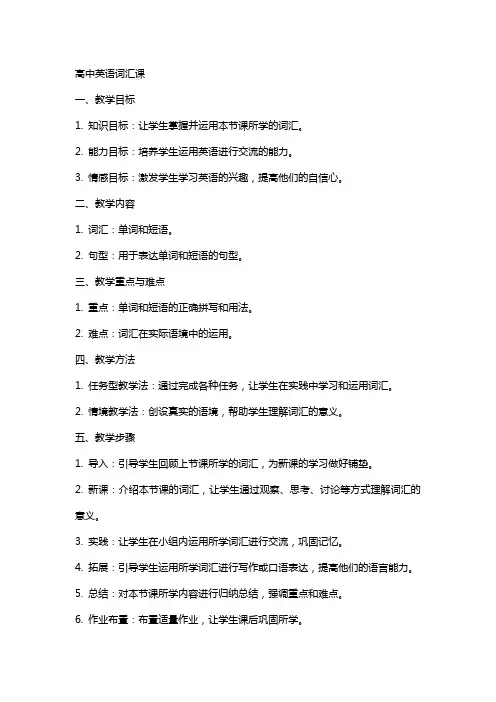
高中英语词汇课一、教学目标1. 知识目标:让学生掌握并运用本节课所学的词汇。
2. 能力目标:培养学生运用英语进行交流的能力。
3. 情感目标:激发学生学习英语的兴趣,提高他们的自信心。
二、教学内容1. 词汇:单词和短语。
2. 句型:用于表达单词和短语的句型。
三、教学重点与难点1. 重点:单词和短语的正确拼写和用法。
2. 难点:词汇在实际语境中的运用。
四、教学方法1. 任务型教学法:通过完成各种任务,让学生在实践中学习和运用词汇。
2. 情境教学法:创设真实的语境,帮助学生理解词汇的意义。
五、教学步骤1. 导入:引导学生回顾上节课所学的词汇,为新课的学习做好铺垫。
2. 新课:介绍本节课的词汇,让学生通过观察、思考、讨论等方式理解词汇的意义。
3. 实践:让学生在小组内运用所学词汇进行交流,巩固记忆。
4. 拓展:引导学生运用所学词汇进行写作或口语表达,提高他们的语言能力。
5. 总结:对本节课所学内容进行归纳总结,强调重点和难点。
6. 作业布置:布置适量作业,让学生课后巩固所学。
教案模板:1. 教学目标2. 教学内容3. 教学重点与难点4. 教学方法5. 教学步骤逐字稿:1. 导入(5分钟)回顾上节课所学的词汇引入本节课的主题2. 新课(15分钟)介绍本节课的词汇讲解词汇的拼写、意义和用法3. 实践(10分钟)学生在小组内运用所学词汇进行交流教师巡回指导,纠正错误4. 拓展(10分钟)引导学生运用所学词汇进行写作或口语表达学生展示,教师评价5. 总结(5分钟)归纳总结本节课所学内容强调重点和难点6. 作业布置(5分钟)布置适量作业,让学生课后巩固所学六、教学评价1. 评价方式:采用课堂表现、作业完成情况和小测验等多种方式进行评价。
2. 评价内容:学生对词汇的掌握程度、运用能力以及课堂参与度。
七、教学反思1. 反思内容:教学过程中的成功与不足之处。
2. 反思方式:通过学生反馈、自我总结和同行交流等方式进行。
八、教学拓展1. 拓展内容:与本节课主题相关的词汇和短语。
高中英语教资教案设计全套4篇
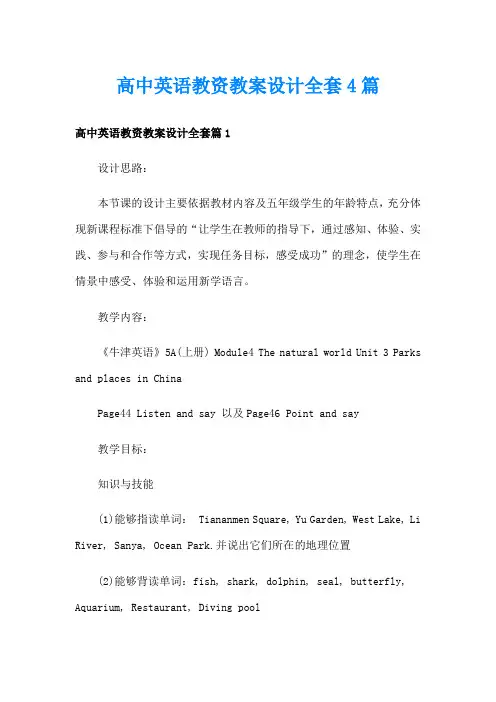
高中英语教资教案设计全套4篇高中英语教资教案设计全套篇1设计思路:本节课的设计主要依据教材内容及五年级学生的年龄特点,充分体现新课程标准下倡导的“让学生在教师的指导下,通过感知、体验、实践、参与和合作等方式,实现任务目标,感受成功”的理念,使学生在情景中感受、体验和运用新学语言。
教学内容:《牛津英语》5A(上册) Module4 The natural world Unit 3 Parks and places in ChinaPage44 Listen and say 以及Page46 Point and say教学目标:知识与技能(1)能够指读单词: Tiananmen Square, Yu Garden, West Lake, Li River, Sanya, Ocean Park.并说出它们所在的地理位置(2)能够背读单词:fish, shark, dolphin, seal, butterfly, Aquarium, Restaurant, Diving pool(3)能够使用句型:Can we see…? Yes, let’s go to…。
We can see…there.(4)能够用简单的句型描述自己熟悉的城市或旅游景点。
过程与方法学生通过参与,感知,体验和小组合作来主动获取知识并运用于实践中。
情感态度(1)通过对自己家乡和祖国风景名胜的了解,激发学生热爱祖国热爱家乡的情感。
(2)在做小导游的游戏活动中培养学生的文化意识和自信品质。
教学重点:能够听、说、认、读单词fish, shark, dolphin, seal, butterfly 并运用句型:Can we see…? Yes, let’s go to…。
We can see…there.教学难点:a : 单词Aquarium、Restaurant的读音b: 用英文介绍自己最熟悉或感兴趣的城市(名胜),并简单用形容词和介词短语来描述这个城市(名胜)的特征,方位,地理位置,代表建筑等。
教师资格证考试高中英语教案模板
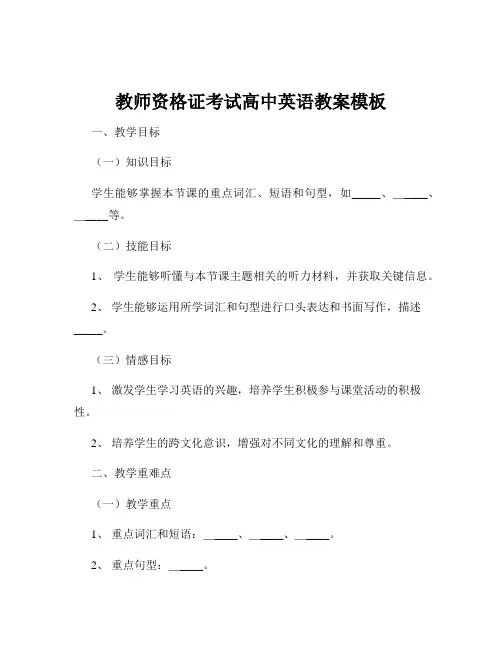
教师资格证考试高中英语教案模板一、教学目标(一)知识目标学生能够掌握本节课的重点词汇、短语和句型,如_____、_____、_____等。
(二)技能目标1、学生能够听懂与本节课主题相关的听力材料,并获取关键信息。
2、学生能够运用所学词汇和句型进行口头表达和书面写作,描述_____。
(三)情感目标1、激发学生学习英语的兴趣,培养学生积极参与课堂活动的积极性。
2、培养学生的跨文化意识,增强对不同文化的理解和尊重。
二、教学重难点(一)教学重点1、重点词汇和短语:_____、_____、_____。
2、重点句型:_____。
(二)教学难点1、如何引导学生正确运用所学词汇和句型进行口语和书面表达。
2、帮助学生理解和掌握某些复杂的语法结构,如_____。
三、教学方法(一)任务驱动法通过布置任务,让学生在完成任务的过程中学习和运用知识。
(二)情景教学法创设真实的语言情景,让学生在情景中感受和运用语言。
(三)合作学习法组织学生进行小组合作学习,培养学生的合作能力和交流能力。
四、教学过程(一)导入(Warmingup)通过播放一段与本节课主题相关的视频、歌曲或展示图片等方式,引起学生的兴趣,导入本节课的主题。
例如,展示一些世界各地著名的旅游景点的图片,然后提问学生:“Do you like traveling? Where do you want to go?”(二)呈现(Presentation)1、呈现新单词和短语利用图片、实物、动作等方式,直观地呈现本节课的重点单词和短语,如_____、_____、_____等,并带领学生跟读、拼写,帮助学生记忆。
2、呈现重点句型通过创设情景,引出重点句型,如_____。
然后,对句型进行结构分析和讲解,让学生理解句型的用法。
(三)练习(Practice)1、听力练习播放一段与本节课主题相关的听力材料,让学生听后回答问题,训练学生的听力理解能力。
2、口语练习组织学生进行小组讨论或角色扮演,运用所学的单词、短语和句型进行交流,提高学生的口语表达能力。
关于教师资格证高中英语教案模板
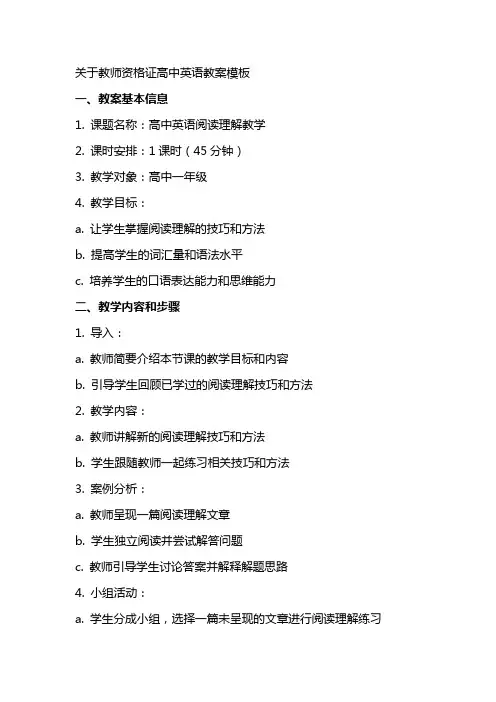
关于教师资格证高中英语教案模板一、教案基本信息1. 课题名称:高中英语阅读理解教学2. 课时安排:1课时(45分钟)3. 教学对象:高中一年级4. 教学目标:a. 让学生掌握阅读理解的技巧和方法b. 提高学生的词汇量和语法水平c. 培养学生的口语表达能力和思维能力二、教学内容和步骤1. 导入:a. 教师简要介绍本节课的教学目标和内容b. 引导学生回顾已学过的阅读理解技巧和方法2. 教学内容:a. 教师讲解新的阅读理解技巧和方法b. 学生跟随教师一起练习相关技巧和方法3. 案例分析:a. 教师呈现一篇阅读理解文章b. 学生独立阅读并尝试解答问题c. 教师引导学生讨论答案并解释解题思路4. 小组活动:a. 学生分成小组,选择一篇未呈现的文章进行阅读理解练习b. 小组成员共同讨论并解答问题c. 各小组派代表分享答案和解题思路5. 总结和反馈:a. 教师对学生的表现进行评价和反馈b. 学生总结本节课所学的阅读理解技巧和方法三、作业布置1. 让学生课后完成一篇阅读理解练习题2. 要求学生在练习过程中运用本节课所学的技巧和方法四、教学评估1. 教师通过课堂观察和作业批改了解学生对阅读理解技巧和方法的掌握程度2. 在下一节课开始时,教师可以对学生的作业进行点评和讲解五、教学延伸1. 教师可以引导学生进行拓展阅读,提高学生的阅读水平和词汇量2. 教师可以组织阅读理解竞赛,激发学生的学习兴趣和竞争意识六、教学资源准备1. 教师准备一篇适合高中生的阅读理解文章。
2. 为学生准备相关的阅读理解练习题。
3. 需要准备黑板和多媒体教学设备,用于展示文章和呈现教学内容。
七、教学注意事项1. 确保学生已经掌握了基本的阅读理解技巧,以便能够理解并应用新的教学内容。
2. 在讲解新技巧时,要清晰、简洁地表达,以便学生能够容易理解和掌握。
3. 在小组活动环节,要确保每个学生都有机会参与到讨论和解答问题中。
八、教学反馈与调整1. 在课后,教师应收集学生的作业,对学生的阅读理解能力进行评估。
关于教师资格证高中英语教案模板

关于教师资格证高中英语教案模板一、教学目标1. 知识目标:让学生掌握高中英语课程标准要求的基本词汇、语法和句型,提高学生的英语听说读写能力。
2. 能力目标:培养学生运用英语进行交流、合作和解决问题的能力。
3. 情感目标:激发学生学习英语的兴趣,培养学生的自信心和自主学习能力。
二、教学内容1. 教材:人教版高中英语教材2. 单元主题:Unit 1 Getting to Know Each Other3. 课时安排:2课时三、教学过程1. 导入:通过图片和问题引入新课,激发学生的学习兴趣。
2. 课堂活动:a) 学生分组进行自我介绍,练习使用目标语言。
b) 教师组织学生进行角色扮演,模拟真实场景。
3. 练习:学生完成课后练习题,巩固所学知识。
4. 总结:教师对课堂内容进行总结,强调重点知识点。
四、教学评价1. 课堂参与度:观察学生在课堂活动中的参与情况,评价学生的积极性。
2. 语言运用能力:评估学生在角色扮演等环节中的语言表达能力。
3. 课后练习:检查学生完成的练习题,评估学生的掌握程度。
五、教学资源1. 教材:人教版高中英语教材2. 图片:与课堂内容相关的图片3. 多媒体课件:用于辅助教学六、教学策略1. 交际式教学法:通过小组活动、角色扮演等形式,让学生在实际语境中运用英语,提高口语交际能力。
2. 任务型教学法:教师设计各种任务,引导学生参与课堂实践,培养学生的综合语言运用能力。
3. 情境教学法:创设真实、生动的情境,让学生在情境中自然地学习和使用英语。
七、教学步骤1. Step 1: 导入新课,展示图片,引导学生谈论相关话题。
2. Step 2: 教师讲解新知识点,如词汇、语法和句型。
3. Step 3: 学生进行小组活动,练习使用新学的语言点。
4. Step 4: 角色扮演:学生分角色表演,运用所学知识。
5. Step 5: 教师组织学生进行听力、阅读和写作训练。
6. Step 6: 课堂总结,布置课后作业。
教师资格证考试高中英语教案模板
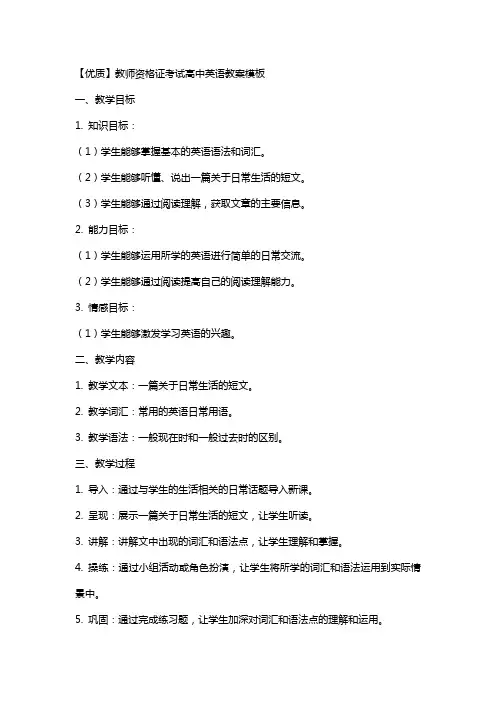
【优质】教师资格证考试高中英语教案模板一、教学目标1. 知识目标:(1)学生能够掌握基本的英语语法和词汇。
(2)学生能够听懂、说出一篇关于日常生活的短文。
(3)学生能够通过阅读理解,获取文章的主要信息。
2. 能力目标:(1)学生能够运用所学的英语进行简单的日常交流。
(2)学生能够通过阅读提高自己的阅读理解能力。
3. 情感目标:(1)学生能够激发学习英语的兴趣。
二、教学内容1. 教学文本:一篇关于日常生活的短文。
2. 教学词汇:常用的英语日常用语。
3. 教学语法:一般现在时和一般过去时的区别。
三、教学过程1. 导入:通过与学生的生活相关的日常话题导入新课。
2. 呈现:展示一篇关于日常生活的短文,让学生听读。
3. 讲解:讲解文中出现的词汇和语法点,让学生理解和掌握。
4. 操练:通过小组活动或角色扮演,让学生将所学的词汇和语法运用到实际情景中。
5. 巩固:通过完成练习题,让学生加深对词汇和语法点的理解和运用。
6. 总结:对本节课所学的内容进行总结,帮助学生形成知识体系。
四、作业布置1. 完成课后练习题。
2. 编写一篇关于自己日常生活的短文。
五、教学反思通过本节课的教学,学生能够掌握基本的英语语法和词汇,并能够运用到实际情景中。
学生的阅读理解能力和日常交流能力也得到了提高。
在教学过程中,教师需要关注学生的学习情况,及时调整教学方法和节奏,以确保教学效果的达成。
六、教学评价1. 形成性评价:通过课堂互动、提问和小组活动,及时了解学生对教学内容的理解和掌握情况。
2. 终结性评价:通过课后作业和练习题的完成情况,评估学生对本节课所学知识的掌握程度。
七、教学拓展1. 开展英语角活动,让学生有机会在日常生活中运用所学的英语。
2. 组织英语演讲比赛,提高学生的英语表达能力和自信心。
八、教学资源1. 英语教材:提供丰富多样的教学内容,帮助学生掌握英语知识。
2. 多媒体教学设备:通过音频、视频等资源,增加课堂的趣味性,提高学生的学习兴趣。
教师资格证考试高中英语教案模板
教师资格证考试高中英语教案模板一、教学目标1. 知识目标:(1)掌握高中英语课程标准要求的基本语法、词汇和功能用语;(2)了解相关文化背景知识,提高跨文化交际能力;(3)培养学生的阅读理解、听力、口语和写作技能。
2. 能力目标:(1)提高学生的英语听说读写综合运用能力;(2)培养学生的自主学习能力和合作精神;(3)提升学生的语言表达和思维能力。
3. 情感目标:(1)激发学生学习英语的兴趣和自信心;(2)培养学生的国际化视野和人文素养;(3)引导学生树立正确的价值观和人生观。
二、教学内容1. 教材:人教版高中英语教科书2. 单元主题:人与自然3. 教学课时:45分钟三、教学过程1. 导入:(1)利用图片、歌曲等吸引学生注意力;(2)引导学生回顾上一节课的内容,为新课学习做好铺垫。
2. 课堂讲解:(1)讲解本节课的重点语法和词汇;(2)通过例句和练习,帮助学生理解语法和词汇的用法;(3)介绍相关文化背景知识,提高学生的跨文化交际能力。
3. 课堂实践:(1)分组讨论:学生围绕主题进行小组讨论,锻炼口语表达能力;(2)小组竞赛:开展英语听力、口语、写作竞赛,激发学生的学习兴趣;(3)课堂互动:教师提问,学生回答,巩固所学知识。
4. 课后作业:(1)布置适量的作业,巩固课堂所学知识;(2)鼓励学生进行自主学习,提高学习效果。
四、教学评价1. 课堂表现:观察学生在课堂上的参与程度、发言情况等;2. 作业完成情况:检查学生作业的完成质量和速度;3. 考试成绩:定期进行单元测试,评估学生的学习效果。
五、教学资源1. 教科书;2. 教学课件;3. 图片、歌曲等辅助教学材料;4. 网络资源:如英语学习网站、在线词典等。
六、教学策略1. 情境教学:通过设定真实的生活情境,让学生在实际语境中学习英语;2. 任务型教学:布置具有挑战性的任务,让学生在完成任务的过程中运用英语;3. 交际式教学:鼓励学生积极参与课堂互动,提高口语表达能力和交际能力;4. 自主学习:引导学生制定学习计划,培养独立思考和解决问题的能力;5. 差异化教学:关注学生的个体差异,给予不同程度的学生个性化的指导。
教师资格证考试高中英语教案模板
【优质】教师资格证考试高中英语教案模板教案章节:第一章至第五章第一章:教学目标与方法1.1 教学目标了解并能运用基本的英语语法和词汇。
提高学生的听、说、读、写能力,使其在实际情境中运用英语。
培养学生的英语学习兴趣和自信心。
1.2 教学方法采用任务型教学法,通过实际任务训练学生的英语实际应用能力。
运用交际法,让学生在互动中提高英语听说能力。
利用情境教学法,创设真实情境,增强学生的语言实践体验。
第二章:教学内容与步骤2.1 教学内容英语语法和词汇的基本知识。
日常交流场景的对话练习。
英语阅读和写作的基本技巧。
2.2 教学步骤步骤一:引入新知识,通过图片、实物等方式激发学生兴趣。
步骤二:讲解和演示新知识,让学生理解和掌握。
步骤三:实践练习,让学生在实际交流中运用新知识。
步骤四:巩固复习,通过游戏、练习等方式加强学生对知识的记忆。
第三章:教学评价3.1 评价方式平时作业:检查学生的英语写作和语法运用能力。
课堂表现:观察学生在课堂上的参与程度和表现。
期中期末考试:全面检测学生的英语水平。
3.2 评价内容英语语法和词汇的掌握程度。
听、说、读、写四项基本技能的应用能力。
英语学习兴趣和自信心的培养情况。
第四章:教学资源与工具4.1 教学资源英语教材、教辅资料。
音频、视频教学资源。
网络教学资源。
4.2 教学工具投影仪、电脑等多媒体教学设备。
实物、图片等教学辅助工具。
练习册、测试卷等教学资料。
第五章:教学计划与安排5.1 教学计划每周安排一定的课时进行英语教学。
根据学生的学习进度和实际情况,调整教学内容和节奏。
5.2 教学安排每节课安排一定的时间进行新知识讲解和演示。
安排一定的时间进行实践练习和巩固复习。
第六章:课堂活动设计6.1 活动设计设计有趣的英语游戏,让学生在游戏中学习英语。
组织角色扮演活动,让学生模拟真实场景进行英语交流。
开展小组讨论活动,促进学生之间的互动和合作。
6.2 活动实施活动一:英语单词接龙游戏,培养学生词汇记忆和反应能力。
教师资格证考试高中英语教案模板
高中英语教案模板一、教学目标1. 知识目标:让学生掌握教师资格证考试高中英语阶段的基本语法、词汇和句型。
2. 能力目标:提高学生的英语听说读写能力,使他们能够熟练运用所学知识进行日常交流和表达。
3. 情感目标:激发学生对英语学习的兴趣,培养他们的自信心和自主学习能力。
二、教学内容1. 语法:动词时态、名词性从句、定语从句、状语从句等。
2. 词汇:生活中常见的动词、名词、形容词和副词。
3. 句型:疑问句、否定句、祈使句、感叹句等。
三、教学方法1. 任务型教学法:通过完成各种实际任务,让学生在实践中学习和运用英语。
2. 交际法:鼓励学生积极参与课堂互动,提高他们的口语表达能力和交际技巧。
3. 情境教学法:创设真实的语言环境,让学生在情境中学习英语。
四、教学步骤1. 热身活动:引导学生进行简单的英语自我介绍,营造轻松的课堂氛围。
2. 语法讲解:通过示例和练习,讲解本节课的重点语法知识。
3. 词汇学习:通过图片、实物等方式,引导学生学习本节课的关键词汇。
4. 句型练习:让学生运用所学语法和词汇进行句型练习,巩固知识点。
5. 小组活动:学生分组进行对话练习,提高口语表达能力。
7. 作业布置:布置适量的课后作业,巩固所学知识。
1. 课堂表现:观察学生在课堂上的参与程度、发音准确性、语法正确性等。
2. 作业完成情况:检查学生作业的完成质量,对错误进行纠正和指导。
3. 测试成绩:定期进行测试,评估学生的学习进度和成果。
六、教学资源1. 教材:使用教师资格证考试高中英语教材,如《高中英语》等。
2. 辅助材料:英语报纸、杂志、网络资源等,用于扩展学生的阅读和词汇量。
3. 多媒体设备:投影仪、计算机、音响等,用于展示教学内容和进行听力练习。
4. 教学挂图:用于展示语法结构和词汇图片。
5. 练习册:用于学生课后练习和巩固所学知识。
七、教学重点与难点1. 教学重点:掌握教师资格证考试高中英语阶段的基本语法、词汇和句型。
2. 教学难点:正确运用语法和词汇进行实际交流和表达。
教师资格高中英语教案设计模板
---一、教学目标1. 知识与技能目标:- 学生能够熟练掌握本节课的核心词汇和句型。
- 学生能够运用所学知识进行基本的听说读写活动。
- 学生能够通过语境理解和使用目标语言。
2. 过程与方法目标:- 通过参与课堂活动,提高学生的听说能力。
- 通过小组合作,培养学生的团队协作能力和沟通能力。
- 通过自主学习,提高学生的自主学习能力和解决问题的能力。
3. 情感态度与价值观目标:- 激发学生对英语学习的兴趣,培养良好的学习习惯。
- 培养学生的跨文化交际意识,提高学生的国际视野。
- 增强学生的自信心,培养积极向上的学习态度。
二、教学重难点1. 教学重点:- 熟练掌握本节课的核心词汇和句型。
- 能够运用所学知识进行基本的听说读写活动。
2. 教学难点:- 在实际语境中灵活运用所学词汇和句型。
- 在交流中准确、流畅地表达自己的观点。
三、教学过程1. 导入(5分钟):- 通过图片、歌曲、游戏等方式,激发学生的学习兴趣,引入本节课的主题。
2. 新授(20分钟):- 词汇教学:通过实物、图片、动作等手段,展示本节课的核心词汇,并进行讲解和练习。
- 句型教学:通过情景对话、角色扮演等方式,让学生理解和掌握本节课的核心句型。
- 语法教学:讲解本节课涉及的语法知识点,并通过练习巩固。
3. 练习(15分钟):- 听力和口语练习:通过听力材料和口语练习,提高学生的听说能力。
- 阅读和写作练习:通过阅读材料和写作练习,提高学生的阅读和写作能力。
4. 总结(5分钟):- 回顾本节课所学内容,强调重点和难点。
- 对学生的表现进行评价,并提出改进建议。
四、教学评价1. 课堂表现:观察学生在课堂上的参与程度、发言积极性、合作能力等。
2. 作业完成情况:检查学生的作业完成情况,了解学生的学习效果。
3. 测试:通过单元测试或期中、期末考试,评估学生的学习成果。
五、教学反思1. 教学效果:分析本节课的教学效果,总结成功经验和不足之处。
2. 教学改进:针对不足之处,提出改进措施,以提高教学质量。
- 1、下载文档前请自行甄别文档内容的完整性,平台不提供额外的编辑、内容补充、找答案等附加服务。
- 2、"仅部分预览"的文档,不可在线预览部分如存在完整性等问题,可反馈申请退款(可完整预览的文档不适用该条件!)。
- 3、如文档侵犯您的权益,请联系客服反馈,我们会尽快为您处理(人工客服工作时间:9:00-18:30)。
教师资格考试高中英语教学设计语音课TopicTeaching Aims:1.Knowledge aim: The students will be able to know how to pronounce…/whatis…2.Ability aim: The students will be able to pronounce ...3.Emotional aim: The students will be able to pronounce ... more confidently. Teaching methods:3-P model (Presentation, Practice, Production)Teaching Aid: blackboard, PowerPoint, some cards, picture of vocal organTeaching Procedures:1.Step 1: Greeting and Lead-in①Daily greeting②Lead-in:2.Step 2: presentationShow some cards to the students and ask them what it is.(Ask student to read three sentences)3.Step 3: PracticeLet students practice the sound, and explain the right way to pronounce the sound.4.Step 4: ProductionSound discrimination and tongue twister5.Step 5: Summary (or consolidation)T: Today, we have learned …, please remember the right way to pronounce... You should practice more after class.6.Step 6: HomeworkPractice the…with your partner and find more example of …Teaching reflection:Blackboard Design:案例:一、音标教案Lessen plan for the pronunciation of /iə/Teaching aims:(1)Knowledge aim: be able to know how to pronounce the diphthong /iə/(2)Ability aim: By the end of the class, students should be able to pronounce the diphthong/iə/(3)Emotional aim: be able to pronounce the /iə/more confidentlyTeaching methods: 3-P model(Presentation, Practice, Production)Teaching aids: chock, blackboard, some cardsTeaching procedure:1)StepⅠGreeting and Lead-in2)StepⅡPresentationShow some cards to the students. Lead in the diphthong /iə/3)StepⅢPracticeexplain the right way to pronounce the sound and practice the students the sound /iə/. 4)StepⅣProductionSound discrimination and tongue twisterStepⅤSummarizeStepⅥHomeworkPractice the diphthong /iə/ with your partner.稿子:Class begins. Good morning/afternoon, boys and girls. Nice to have this English class with you. Today we are going to learn a diphthong in English.T: first,I will show some cards. Do you know, what is this in English?T: yes, very good. This is a deer. Now read after me, deer.T: deerT: OK, very good. Then the second one, what is this in English?T: good. This is a girl. And what is she doing now?T: Yes, she is crying, so in her eyes, there is …T: excellent! There are tears in her eyes. Read after me. TearT: tearT: Ok. Now, another picture, what is this in English?T: you are great. This is a bottle of beer. Now read after me, beerT: beerT: Ok. We have learned these three words: deer, tear and beer. From these words, can you find something in common?T: yes, very good. These words all contain the sound/iə/. Now read after me, /iə/ /T: /iə/T: /iə/T: Now, do you know the right way to pronounce the diphthong /iə/?T: this is a diphthong. It begins with the first sound /i/,( write the /i/ on the blackboard) and glide towards the second sound /ə/,( write the /ə/ on the blackboard) remember?T: Ok, very good. Now who can pronounce the sound? Aslan, you, pleaseT: /iə/, read after me.T: yes, very good. Lily, can you?T: OK Good. Candy, pleaseT: yes, very good.T: Ellen, how about you?T: Good. But you should change the shape of your mouth as you move from one sound to another. Now, look at the position of my lips when I pronounce this sound. /iə/, /iə/, /iə/. Now read after me, /iə/T: OK, excellent. Now, the whole class read after me. /iə/T: /iə/T: /iə/.T: /iə/.T: very good. Now, I will divide you into two groups. Group 1 read the sound three times, and then group 2. Do I make myself clear?S: Yes.T: /iə/. One two go.T: very good. Now group2T: good. You all have done a good job. Now le t’s do some exercise of sound discrimination. Listen to me carefully and circle the words which contain the sound /iə/ from each of the following pairs. N.1, peer pearT: excellent. N.2, tare tearT: are you sure?T: OK, very good. N.3deer dareT: great! N.4 mere mareT: you are so smart. Now, please look at the blackboard. There is a tongue twister. Who can read it out? Miky, you, please.T: very good. A deer and a mare spare mere one second to drink a bottle of beer without tears. And who would like to try? cuqi, please.T: excellent!T: today, we have learned the sound /iə/; remember the right way to pronounce this sound. It begins with the first sound /i/ and glide towards the second sound /ə/, you should practice more after class. Your homework is to practice the diphthong /iə/ with your partner. OK. That's all for today's class. See you!TopicTeaching Aims:1.Knowledge aim: The students will be able to know how to pronounce…/whatis…2.Ability aim: The students will be able to pronounce ...correctly3.Emotional aim: The students will be able to speak English more confidently. Teaching methods:3-P model (Presentation, Practice, Production)Teaching Aid: blackboard, PowerPoint, some cards,Teaching Procedures:1.Step 1: Greeting and Lead-in①Daily greeting②Lead-in: play a video and ask the students to pay attention to thepronunciation of native speakers. Then, ask some question about the video: What are they talking about? Do you notice how they pronounce …? …2.Step 2: presentationRead the text and ask students to underline the parts where the pronunciation phenomenon is similar with the one shown in the video.Ask students to conclude the common point of those parts.Based on what students say, explain the pronunciation phenomenon3.Step 3: PracticeAsk students to read the text again.Ask students to read the examples on PPT.4.Step 4: ProductionSound discrimination and tongue twisterAsk students to discuss… with their partners.5.Step 5: SummaryBriefly summarize the skill to pronounce …6.Step 6: HomeworkPractice the…with your partner and find more example of …Teaching reflection:Blackboard Design:语音教学试讲真题内容But she began to trust him, she told him how she was overweight and this made her feel unhappy .also she felt her home wasn’t elegant enough f or someone like larry who wanted to improve his social position基本要求针对段落长句设计示范连读重读的教学步骤阅读课Teaching PlanTeaching Aims:1.Knowledge aim: students will be able to understand the main idea and somedetails of the passage.2.Ability aim: students will be able to use reading skills such as skimming andscanning.3.Emotional aim: Students can get more interested in English culture.Teaching Procedures:1.Step one: warming-up lead-in (1 minutes)Greeting.Show the students some pictures or play a song about … and ask them some simple questions: …2.Step two: pre-reading (2 minutes)Common sense on…Ask students to give examples of…Play the video about …. While enjoy the video, students think over the following questions: ….3.Step three: while-reading(4 minutes)Read the text for the students and then ask them to conclude the main idea of the passage.Main idea: …Ask the students to read the passage carefully and decide whether the statements are true or false and explain why:…Ask the students to work in groups and have a discussion on the following questions: …4.Step Four: post-reading(2 minutes)Ask students to retell the passage. Ask students to retell between partners first, then ask two students to retell before class.5.Step Five: Summary and Homework(1 minutes)Briefly review the content learned today.Let the students to write a composition about the ending of this story.T: Good morning, boys and girls. How are you today? Great! Today, we are going to learn a new lesson, but before the class, I want to show you some pictures. Well, what do you see in the pictures? Great! How do you feel about…? Do you have any experience about…?T: Well, …(common sense). Can you name some examples of …? Ok, Peter, please.T: …, yes, great! How about you, Lily?T: … and …. Well done. [Now, I will play a video for you. Please think over ‘…’ while you enjoy the video.]T: Ok, the video is over, who want to share his opinion with us? Aslan, go ahead.T: Thanks for sharing. As we have talked a lot about the …, now open your book and turn to page 51. Let’s move on the learn the text about …. I will read the text for you. While reading, please try to conclude the main idea of the passage. Here we go! (读课文)T: Ok, do you understand the whole passage? Great! So, who volunteer to answer the question: what’s the main idea of the passage? Lily, please.T: Good job! This passage is mainly about … It’s very interesting. Now, please read it carefully and then do the true or false on the PPT.T: Have you fini shed? Good. So is the first statement true or false? Helen, what’s youranswer?T: Yes, it’s true. What about the second one? …(句子)true or false? OK, Stacey please. T: Yes! It’s false. But can you explain why?T: Excellent! It’s false because … Now, the la st one. Any volunteer? Great, Mike, please. T: Yes, it’s true, too. Now, can you understand the whole text? Great. If we must understand this reading material thoroughly, we should pay more attention to each and very fact in this reading material in order to understanding the text.[ In the following part, we will do some further study. Please work in groups and have a discussion on the questions shown on the ppt: … ten minutes.T: Ok, time is up. Which group wants to share your opinion? Great, please!T: Well done. I can feel that you have thought it thoroughly. Is there any group has different opinions? Well, this group.T: you did a good job too. …(问题答案)]T: Well, we have read the text thoroughly and it seems like all of you have understood it. Now please work in pairs and try to retell the passage. I’ll give you ten minutes and then I’ll ask two students to do the presentation. Let’s start.T: Time is up. Who want to retell the passage first? Come on, don’t be shy! Great, Lily. T: Excellent! Anyone else? Mark, please.T: Very good!T: Ok, so much for today. As we have learned … it’s very interesting. Please write a composition about the ending of the story after class. That’s all, you can have a break now.1. 阅读课的教学方案1. Teaching aims:1. Train the students’ reading ability.2. Enable the students to realize ...3. Stimulate(激发)the students’ interest and ... 2. Teaching methods:1. Fast reading to get general idea of the text.2. Careful reading to understand the passage better.3. Teaching procedures(程序):Step1 Lead-inUse some pictures of ... to lead in the topic.Step 2 Pre-reading1. Play a guess game: ...2. Play another guess game: ...Step 3 Predict(预测)1. Ask the students to predict what the reading passage talks about according to the title and illustrations(插图)of passage. The teacher can give some clues by talking about the illustrations:......Step 4 Skimming(略读)1. Let the students skim the whole passage to get the main idea, then evaluate their predictions. During this activity, the teacher should give some guidance(指导)on reading skills.Main idea of the passage:...2. Let the students skim the passage and divide it into different parts to find out the main idea of every part an the topic sentences.Part 1 (paragraph 1...)......Step 5 Careful reading... (问题)Ask the students to scan the second part and complete the chart(图表)with information from the passage.Ask the students to read carefully and finish the following tasks:......Read the statements and decide whether it is true or false and give the reason.(设计一些问题或判断对错等)高中英语阅读课(例子) 教学设计Ⅰ.Teaching Contents 教学内容Module 7 Unit4 Sharing Reading: A Letter HomeII.Analysis of teaching material 教材分析本单元的话题是Sharing,主要涉及帮助弱者、志愿服务、合作分享等。
